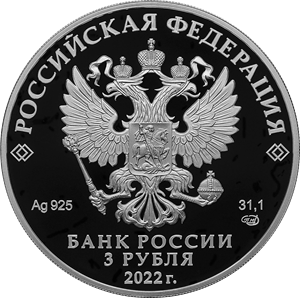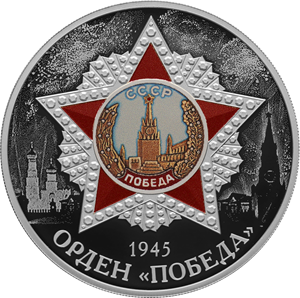The Order of the Victory
Obverse
a relief image of the National Coat of Arms of the Russian Federation, over it along the rim there is the semicircular inscription ‘РОССИЙСКАЯ ФЕДЕРАЦИЯ’ (RUSSIAN FEDERATION) framed on both sides by doubled rhombuses, below under the coat of arms there are indications of the precious metal and its fineness on the left and the fine metal content and the mint trade mark on the right, at the bottom in the centre, in three lines, there is an inscription ‘БАНК РОССИИ’ (BANK OF RUSSIA), the denomination of the coin ‘3 РУБЛЯ’ (3 RUBLES), and the year of issue ‘2022 г.’ (2022).
Reverse
a coloured relief image of the Order of the Victory against the background of the images of the Kremlin and festive fireworks; at the bottom, along the rim, there is an inscription: ‘ОРДЕН ‘ПОБЕДА’ (THE ORDER OF THE VICTORY) and a date ‘1945’ above it.
Authors
Designers: E.V. Kramskaya (obverse), A.A. Brynza (reverse).
Sculptors: A.A. Dolgopolova (obverse, reverse), computer simulation (reverse).
Mint: Saint Petersburg Mint (СПМД).
Edge: 300 corrugations.
Discover more
The highest military award in the USSR – the Order of the Victory – was established by the Decree of the Presidium of the Supreme Soviet of the USSR on 8 November 1943.
The Order is made in the form of a convex pentagonal ruby star with rays between the opposite arms measuring 72 mm in diameter. Large rubies framed with diamonds are inserted into the platinum arms of the star. In the centre of the star is a rounded silver medallion, 31 mm in diameter, with the Moscow Kremlin wall, the Spasskaya Tower, and Lenin’s Mausoleum depicted in gold with the letters ‘CCCP’ (USSR) above them. The medallion is surrounded by bands of gold laurel and oak leaves. The star of the Spasskaya Tower has a natural ruby mounted in it; small diamonds are inserted between the laurel and oak leaves. The Order of the Victory is made of platinum. The total weight of the inserted diamonds of the Order is 16 carats.
The red five-pointed star, which became the basis of the Order, was the emblem of the Red Army since 1918. According to ancient beliefs, the diamonds that bordered it were considered the talisman of warlords giving them courage and victory. The light blue colour of the medallion in the centre of the Order symbolised peace and tranquillity, the laurel branches – glory, and the oak leaves interwoven with the laurel – strength and perseverance.
The Order, because of the use of platinum, gold, silver, diamonds and rubies, is the most expensive one in the history of awards. As for the number of copies, it is the rarest decoration with only 19 recipients.
The Order of the Victory, as the highest military award, was bestowed to senior officers of the Red Army for the successful military operations with the involvement of one or several fronts which resulted in a radical change of the situation in favour of the Red Army.
The first Order of the Victory was granted on 10 April 1944. Recipients of the highest Soviet military award then were Commander of the 1st Ukrainian Front Marshal Georgy Zhukov, Chief of the General Staff Marshal Aleksandr Vasilevsky, and Supreme Commander-in-Chief Marshal Joseph Stalin.
Later, the Order of the Victory was awarded to Marshals of the USSR Leonid Govorov, Ivan Konev, Rodion Malinovsky, Kirill Meretskov, Konstantin Rokossovsky Semyon Timoshenko, Fyodor Tolbukhin, and Army General Aleksei Antonov for their outstanding achievements.
In 1945, the awarding of the Order of Victory was discontinued.
Source: https://mil.ru


